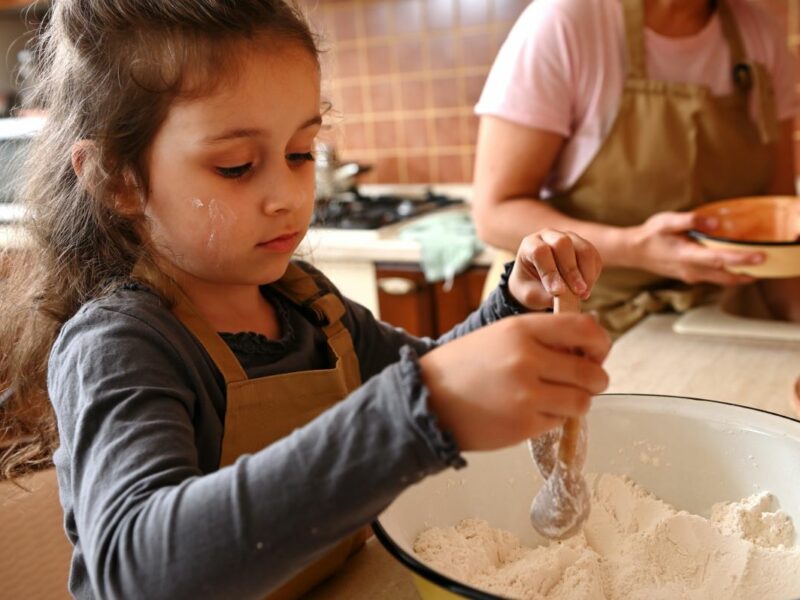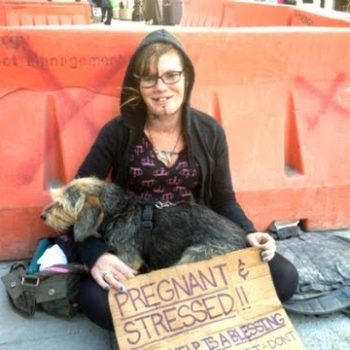At the corner of a random intersection in middle America, a newborn baby cries for the first time. Fresh eyes take in new scenery – a city street, an open field, perhaps the rush of a traffic jam. There is no doctor there to check the baby’s heartbeat. There is no hospital bassinet to keep the newborn safe and warm. Receiving blankets and infant bonnets, breastfeeding instructors and midwives are off the table.
In terms of society, this baby is alone – born into homelessness.
If the little one is fortunate enough to survive infancy and childhood on the cold, hard streets of Anywhereville, USA, it will only be to hear hurtful words like “get a job!” or worse, in adolescence and adulthood. Perhaps even more tragically, this infant is unlikely to survive to hear that hurtful expression in passing or even be born at all.
Homeless pregnant women face unfathomable obstacles to securing housing, be that permanent or temporary accommodation. Earlier this year, a group of housing, healthcare, and social welfare experts produced a report titled Healthy Parents Healthy Babies (alternatively referred to as HPHB), which ultimately concluded that “The stress of housing instability and homelessness leads to poor birth and health outcomes that can extend across individuals’ lifetimes.”
“The reason they can’t put (me) in a shelter is cause I’m pregnant, and there’s no bottom bunks,” explained 20-year-old Serenity in an eye-opening street interview with Invisible People. “I’m a liability,” she continued, elaborating on the comments she regularly hears from social workers, law enforcement officials, and passersby.
“Why are you out here on the streets if you’re pregnant?” they taunt. “Well, why don’t you guys help me get off the streets?” she replies.
There is no doubt that a nationwide decline in both birth rates and infant health outcomes needs to be addressed. These issues exist all across the country in various communities, but they are most pronounced within the homeless population.
For this reason, several pilot programs have been launched with the mission of helping homeless pregnant women navigate the perinatal period, which is the window starting from the time of pregnancy that lasts up to a year post-partum. One of the most successful of these types of programs is Ohio’s “Healthy Beginnings at Home.”
A Look at Healthy Beginnings at Home: A Promising Prospect for Future Foundations
Healthy Beginnings at Home is an Ohio-based research project that aims to increase birth outcomes by providing housing for homeless pregnant women. According to experts in the field, the overwhelming success of the study has positive nationwide implications. Perhaps hope for a brighter future is not entirely lost.
“We demonstrated through Healthy Beginnings at Home that by providing housing during their pregnancy, women who had been homeless/housing unstable were able to deliver healthy, full-term babies compared to their peers who did not receive housing (78% compared to just 55%). Not only were health outcomes better, the cost of delivery and subsequent healthcare was much lower,” explained former executive director of the U.S. Interagency Council on Homelessness Barbara J Poppe in an exclusive discussion with Invisible People.
The Impact of Healthy Beginnings at Home on Pregnant Women in Unstable Housing is Immense
To learn more about the initiative and the impact it could potentially have nationwide, we reached out to the executive director for the Coalition on Housing and Homelessness in Ohio, Amy Riegel.
“The Healthy Beginnings at Home program is focused on looking at the connection between stable housing and healthy birth outcomes,” Amy said. “For the women who participate in the program, the intervention is that they receive housing assistance for a period of two years to take them through their pregnancy, through the baby’s first birthday, and then a little bit beyond that period.”
“What we found in the program is that when the women received the intervention, they were more likely to have a full-term, healthy birth weight baby,” Amy continued. “The women who participated in the program were also more likely to avoid needing any of the neonatal intensive care unit treatment after delivering their babies. This means that they were able to go home with their baby. That baby would then have a great start in life.”
Creating Healthier Birth Outcomes for Pregnant Women Enduring Homelessness and Their Babies
Having a safe, reliable space to call home helped the program participants in many ways. From being able to get to doctor’s appointments and having access to things like prenatal vitamins, much of the stress associated with their pregnancy was alleviated.
“Many of the women still struggled to pay rent after participating in the program. They were still receiving food stamps. Some of them were receiving WIC, but their health was improving, and their outcomes for their baby were better merely by having stable housing in their lives,” Amy said. “We often think of health outcomes as something that needs to be solved in a doctor’s office or treated in a doctor’s office. This actually shows that one of the greatest things we can give people isn’t a pill or a shot or a prenatal vitamin. It’s stable housing.”
Winning Strategies and How to Take Them to a National Level
One of the most effective strategies was giving the women affordable housing, and not just for a couple of months, as is the usual approach. Rather, they received it for an extended time, namely, the perinatal period.
“It was for the period of pregnancy until that baby’s first birthday and then a little bit after. So that period of 24 months seemed to very much help the women to be stable and to have the proper level of stress reduction,” Amy explained.
Another component that made a huge difference in supporting healthy birth outcomes was utilizing a housing specialist.
“There was a person who worked with them to find the housing, to negotiate the lease, to make sure that they had the right furniture when they moved in,” Amy continued. “The housing specialist was there to set up utilities and conduct various other activities… basically, with everything that comes with housing. These specialists stayed with them throughout the whole program.”
“So, for example, if one of the women had a maintenance issue that needed to be completed, they helped her call the landlord and negotiate. If they had a dispute with their neighbor, they helped them find ways to work things out. Most importantly, the women all lived in Columbus, Ohio, where the rent was rapidly increasing during the program, and the housing support specialist was there to help them renegotiate their lease.”
“Oftentimes, programs have somebody who helps them get started, but after that, you’re really on your own,” Amy said. “Being able to have that person there throughout the whole duration of the program seemed to have a significant impact on the women. This, in turn, positively affected birth outcomes.”
No More Tragedies: How Changing the Narrative Means Changing the Way These Stories End and the Way Innocent Lives Begin
While healthier birth outcomes were measured in the results, Amy said the true success of the program was in the individual stories.
“When you hear the stories of every woman who participated in the program, the women who, this was their first baby ever born full-term with a healthy birth weight. Some women were able to leave domestic violence situations because the lease was in their name, and they finally had control over their lives. Some women were able to go back to school and seek higher education. And, of course, the babies were born so happy and healthy.”
“That’s the true success of the program. It’s impressive by the numbers and the savings to state and federal programs, but the individual stories are really why the program matters,” Amy said.
Talk to Your Representatives About Promoting Housing Stability and Healthy Birth Outcomes
Communities with healthy babies are more likely to thrive! Communities thrive in places where healthy babies come home to happy situations.
The success of the Healthy Beginnings program has sparked national interest, with over a dozen states now expressing interest in replicating the initiative. Talk to your representatives about investing in the promotion of housing stability for homeless pregnant women all across the country today.













